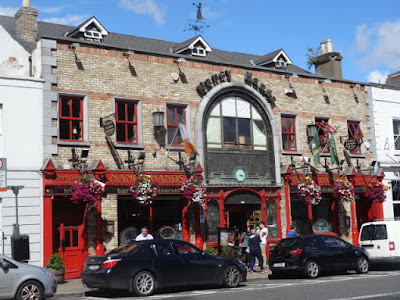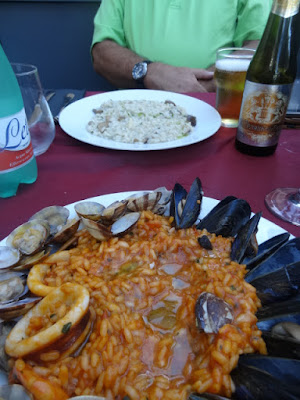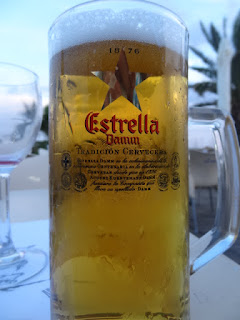 |
| There's more to life than beer |
Maes
A
Belgian but unremarkable. I suppose they
can’t all be good. Had it in a bar in
Siena. Perhaps the keg offering is not
as good as a bottle? Would have it if it
was given but I wouldn’t outlay cold hard for it.
Fahnen Brau
Supermarket
beer bought in a chain simply called “CoOp” in northern Italy. They are very cheap. Surprisingly, the can has all the details of
its Australian importers?? What gives? This is northern Italy? Anyway, it is wet and has a taste of hops but
other than the fact that a 500ml can cost €0.71c there is little else to
recommend it. Not unpleasant, like an
overhopped “peach/fruity” IPA but not much punch behind it.
My friend Stephen was
given one of those assorted 6-packs that are popular at Xmas. Being a friend, he waited for me to arrive
before we hopped into it.
Ballast Point. Big Eye India Pale Ale.
7.0% We poured it down the sink. Undrinkable and not unexpected of
an American IPA.
Pintail
Pale Ale. San Diego
again. Called a Pale Ale but really more like an IPA. A bit too
"floral" for mine. Almost got
poured down the sink but we just made rude comments about the brewer’s
parentage.
Vale/Ale
Australian Pale Ale.
McLarenvale. Strange hint of smoke? Adelaide Hills fires? OK to try but not near as good as the SA
stuff that comes out of Coopers.
Nail's
"Golden Nail"
5%. Called a "Hoppy Summer Ale" but again a sweetish overhopped
beer. What is driving this obsession with a massive hop input? I
can't abide it.
James
Squire Nine Tales Amber Ale. Less hoppy, a bit more caramel.
Not bad at all. Despite now being part of a major brewer of rubbish, they have
left the Squire taste to itself and it is a very worthwhile pursuit indeed
drinking Squires of several styles.
Leffe
Blonde. Didn't like it all that much
but it was interesting. Sharpish. Initial taste was a bit of an
assault but the aftertaste was quite pleasant.
Not the “craft beer” you might imagine – owned by AB and made from a
“pretend” ancient recipe, which was actually resurrected not that long ago and
made to seem old.
Moretti
la Rosso. 7.2%. I don't
mind a red or three. Peroni's is quite good, as is Greece's Vergina (even
though I do not like their lagers). This Moretti is just a bit
nothing. No taste, no caramel, just alcohol.
Risotto
In Scario, there is a restaurant at the end
of the quay that specializes in Risotto.
The chef and his wife, who spent 10 years in Sydney before returning to
Italy, claim that their risotto is the best in Italy. It is good.
 |
| The King of Risotto and his Queen |
Birra
Pietra - Corsican. Nothing
remarkable, just rich and well rounded. No over-hopping so no fruity
stuff. Decent head that goes quite quickly. Recommended if you see
it.
Birra
Dell Elba. There are about 8 of
these. Not cheap at €7 a small bottle but that's the price for small
breweries. I had the Maestrale but it had a little too fruity a taste for me -
peaches from the hops. They even have a Stout.
 |
| Elba on Elba |
Isenbeck.
In Genoa, in front of the 518 Submarine, is a
small bar. I had this there from La
Spina.(The Tap) In fact, I had two as it
was so good. The lady said it was Dutch
but apparently it is Argentinian.
Bubbles last for ages, like a good champagne. Rich and smooth with a slight bitter
aftertaste. This is to be hunted
for.!!
Konig Ludovic
Weissbeer
Another Dark wheat beer, which I don’t
mind. Up front, lots of caramel but it
fades quickly and not a lot left after that.
OK but nothing special.
 |
| Facial expression is a subtle gauge of quality |
3 to be
forgotten
We found a small gourmet shop on the
waterfront in Genoa, under the covered archway that runs the length of the
quay. Tried three of the rather
expensive craft beers there,
Geans American Pale Ale 5.5% a beer by Che L’Inse, a Genoese micro-brewery
Bronze Ale – Officially “Bronzin” Ale,
another Che L’Inse offering
Isaac 3.3%.
The 5% seems to be the most widely available but this was definitely
3.3%.
The Geans was “peachy” and sweet, the Bronze
was OK but not worth €3.50 a 330ml bottle and the Isaac was OK but only just.
However, it was pleasant just sitting out in
the walkway watching Genoa go by.
Birra Dana.
Can’t believe I haven’t commented on this
before. Been drinking it for a year now. A “Made for” beer for Conad. Don’t know who makes it but it’s not all that
bad. Perhaps a little on the flat side
(cans only) but the bottles are good.
It’s sold in Conad Supermarkets for 0.67€ per 500ml can. If you’re looking for something to take to a
BBQ, pick this. It’s fine.
St Thomas
Abbaye
Had this in a bar alongside the Petanque
rinks in Bormes e Mimosas. We put in to Bormes when we lost propulsion and had
a mechanic work on CS. The Petanque
courts are well used in the summer holidays and many of the French tourists
(it’s not a foreigner destination) had organised teams and a tournament. You
can sit quite close to the action to watch the games, and the seriousness with
which the players take the outcomes.
I had a litre, in fact, for €13.80. That’s about what some Perth pubs charge for
a glass. This was very good indeed, a
great example of a light-ish Abbey beer.
Look for it.
Hertog Jan
Grand Prestige
Can’t remember where I got this but it was in
the Engel for a while before I tried it.
Not as old as the labelling would pretend it is but nice enough.
Birra
Italiana
This is one of those “made-up” beers that
supermarkets in the Med have on order from major breweries. You just don’t know which brewery makes up
the store brand for them. This one,
despite its name, is actually quite good.
It is on the edge of getting sweet but not there yet. It is made for a Co-op in northern Italy
called….. Co-op! Surprise surprise. These guys have good, very low cost grocery
items and this is one of them. 0.69c per
can, 500ml. Seriously, you could do
worse quite easily. If you find yourself
in a B&B in Italy, and there is a Co-op around, stock up on this stuff and
fridge it.
Back in Australia beers
Hawthorn Brewing
Pale Ale.
They say Pale Ale, and describe it as “A
unique Pale Ale boasting a harmonious blend of specialty malts infused with
fresh fruity hops.” In other words, they
lied, it’s an IPA. And I hate IPA’s of
the sort “young” brewers are making today.
Atrocious stuff. Should have
looked at the description and not the stated type. Not a Pale Ale at all.
Burleigh
Brewing Company”s “My Wife’s Bitter”
My mistake here – I had it on a hot Bunbury
evening. Should have been kept for a
winter’s night with a casserole or a roast.
In season, it would be an excellent choice. Mark it down as a buy in winter.
London
Wimbledon
Common Ale in The
Prince of Wales. OK but at English
prices I wouldn’t bother too much.
Hop House
Lager. A lager from Guinness. Nothing to write home about.
Drayman’s
Drop. Had this ale in Wibbas Down (a chain
bar). Not too bad. Would line up for more without a
problem. Wibbas Down is cheaper than
its competitors – can get a bit willing on Pension Day but good cheap food and
a great selection of tap beers and cider.
They don’t put on enough staff for the demand, though, and you usually
have to wait a while. Good breakfasts,
too, at way lower than most London prices.
Theakston XB.
Had this in the King’s Arms in Greenwich (we
put a bad review of this place on Trip Adviser for other reasons). I assume the XB means extra bitter. Very nice ale. Don’t mind Theakstons Old Peculiar, either.
Boddingtons – they sell this in large
quantities, not small batches. Easy
drinking ale you can depend on. Very
drinkable.
Carling
Lager. One of the few large-volume English
lagers. Very nice, if getting a tiny bit
towards sweetness. Good choice for a
take-home pack in the supermarket.
Old Crown
Bitter. Went into the Old Crown on the corner of New
Oxford Street and Museum Street (just before Drury Lane). Pub is 360 years old. This was a very nice accompaniment to our
fish-and-chip lunch. So nice I had
two. Nothing “in” it, like extra
anything. The brewer, reportedly a young
chappy, has shown admirable restraint by not loading this up and letting it be
a simple bitter. Would that more “young
brewers” did the same and put away the shovel they put the hops in with.
Pistonhead
Kustom Lager. Made in Sweden. Nothing remarkable. OK but not at Gatwick Airport prices of £5 a
330ml can.
Back in Spain
again……
We stayed overnight in Alicante as it was too
late for the bus back to Cartagena.
Needing some food, we wandered around our neighbourhood and found a
small bar run by mum-and-dad. (he had
braces in the colours of the Spanish Flag!).
They had a casserole dish of something on the bench and I asked what it
was. He said three things I understood –
chorizo, jamon and garbanzo. Three out
of whatever was in there sounded good so I asked for two bowls, caliente. He agreed and took the dish over to his wife
to be heated up in the microwave.
He must have thought about this a bit and
decided that two bowls of the same thing was a bit of a waste of time, so he
came back over and asked me to come behind the counter to the fridge. There he showed me other dishes of food, some
of which I had no understanding of. I
asked which were patatas and he showed me two.
I selected one that looked like the French dauphinoise dish.
The potato dish turned out to be garlic and
lemon bashed-up potatoes which was superb, and the bean ham and chorizo dish
had a great gravy in it for us to soak up with our crunchy bread. Carol had a glass of red (he left the bottle
on the table) that cost €2 and was magnificent.
I had my usual Estrella Levante for €1, but I had two. Total cost - €14,
or about the cost of 1 beer in London.
Gordon
Highland Ale
There is a bar in Cartagena called the Yellow
Submarine. It exists for the cruise
liner tourist trade and is right where all the touristas enter town. It does have a large range of foreign
beers. They are a little expensive but
that’s understandable given the lower turnover.
This one was quite nice but would have been better farther north of here
with a roast dinner instead of tapas.
Estrella
Galicia, Estrella Damm, Estrella Levante and CruzCampo.
Spanish beers usually defined by region but
in a modern world they can turn up anywhere.
Pick any one of these and you have a good quaffing lager. Estrella Damm is called “The Beer of
Barcelona” but it is widely available down here in Cartagena, which is supposed
to be Estrella Levante territory. Of the
three Estrellas, I probably lean towards the Levante as it is a bit sharper,
while Galicia and Damm are a bit more towards sweet. CruzCampo is very nice indeed and now comes
in a trendy can which has a “button” on it that goes blue when it’s at ideal
coldness. Wonders will never cease my
mother used to say, but that was mostly when I did something good. Which was not often I might add.
Moritz – a nice enough Barcelona
beer but again tending towards a little sweetness. If your choices are limited and this is on
the tap, it will be fine. Sweeter in the
bottles I think. First came across it
when we entered Spain last year in Palamos.
Carrefours – 13c a can. Ok, so it’s a bit on the light side but I do
draw your attention to the price.
Unfortunately, it can range to stratospheric heights and it is often
0.21c per can. No shit, Sherlock, even
the ½ litre can is only 0.38c. Drinkable
for sure.
 |
All yours Cal, I'm drinking beer 6 euros a jug.
They wouldn't sell this to me in Burriana - display only
|
If you're going to run a bar, you really have to get serious about your beer storage
































































